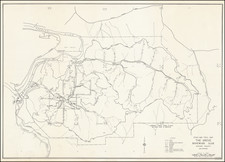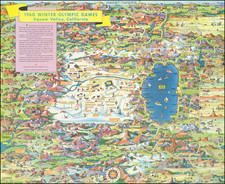A marvelous example of Coronelli's famous 2 sheet map of North America. One of the best examples of California as an island. The map also provides a excellent set of notes on the French explorations in North America, including the explorations of Marquette in 1673 and La Salle in 1682. The map relies heavily on Franquelin's map, including placing the mouth of the Mississippi 600 miles to the west of its true location. One of the truly outstanding decorative maps and an essential map for collectors of 17th Century North America. A nice unjoined example of this highly desireable map. Tooley #57. Cummings, p. 148. Wheat #70. McLaughlin #103. An essential map for collector of California as an Island and the Mississippi Valley.
Vincenzo Maria Coronelli (1650-1718) was one of the most influential Italian mapmakers and was known especially for his globes and atlases. The son of a tailor, Vincenzo was apprenticed to a xylographer (a wood block engraver) at a young age. At fifteen he became a novice in a Franciscan monastery. At sixteen he published his first book, the first of 140 publications he would write in his lifetime. The order recognized his intellectual ability and saw him educated in Venice and Rome. He earned a doctorate in theology, but also studied astronomy. By the late 1670s, he was working on geography and was commissioned to create a set of globes for the Duke of Parma. These globes were five feet in diameter. The Parma globes led to Coronelli being named theologian to the Duke and receiving a bigger commission, this one from Louis XIV of France. Coronelli moved to Paris for two years to construct the King’s huge globes, which are 12.5 feet in diameter and weigh 2 tons.
The globes for the French King led to a craze for Coronelli’s work and he traveled Europe making globes for the ultra-elite. By 1705, he had returned to Venice. There, he founded the first geographical society, the Accademia Cosmografica degli Argonauti and was named Cosmographer of the Republic of Venice. He died in 1718.










![[ Climatology ] Map of California Illustrating Its Climatology -- Comparative Area -- Rail Lines -- Compiled From Official and Authentic Sources By The Southern Pacific . . . 1903](https://storage.googleapis.com/raremaps/img/small/82610.jpg)
![[Mexico and Central America with Baja California inset, from Generalkarte von Nord America samt den Westindischen Inseln Versasst von Herrn. Pownall . . . MDCCLXXXVIII]](https://storage.googleapis.com/raremaps/img/small/95064.jpg)

![[An English Propaganda Map In French] Carte Des Possessions Angloises & Francoises Du Continent De L'Amerique Septentrionale 1755.](https://storage.googleapis.com/raremaps/img/small/86975.jpg)
![A New Map of North America Shewing its Principal Divisions, Chief Cities, Townes, Rivers, Mountains &c. Dedicated to His Highness William Duke of Gloucester [California as an Island]](https://storage.googleapis.com/raremaps/img/small/100578.jpg)